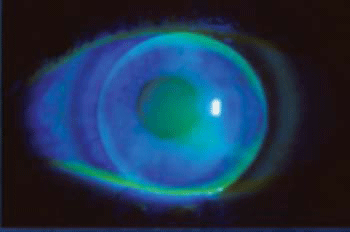Best-corrected visual acuity after corneal transplantation may require the use of a contact lens. Issues of concern include the optical indications for contact lens wear after corneal transplantation, the type of contact lens to be used, timing for contact lens fitting, the presence of sutures, visual outcomes and complications.
Study of Post-PK Fits
At our institution we retrospectively reviewed all contact lens patients seen over a four-year period, who were wearing contact lenses for visual rehabilitation after penetrating keratoplasty. Thirty-five eyes in thirty patients were identified, with an average age of fifty-three. The most common pre-keratoplasty diagnosis was keratoconus (37 percent) followed by Fuchs' Dystrophy (29 percent).
In these patients there were a number of overlapping optical indications for the use of contact lenses. Our goal was to achieve optimal visual function. Twenty-two of 35 eyes fitted had irregular astigmatism; 20/35 eyes had significant spherical anisometropia; and 19/20 eyes had significant astigmatic anisometropia. Three patients were aphakic.
 |
|
Figure 1. A patient fitted with a spherical base curve rigid gas permeable lens after penetrating keratoplasty. The sutures remain. |
In this study, the earliest time a graft was fitted with a contact lens was about eight months post-keratoplasty. Selective suture removal to control astigmatism was pursued first, before considering a contact lens. Upon initial fitting, sutures were present in 40 percent of eyes. Sutures were not considered a contraindication to fitting as long as they were well epithelialized and the wound margin was stable.
An important goal of contact lens fitting was to avoid lens bearing, or chafing, particularly over the graft-host margin, as this can cause problems particularly in patients with sutures remaining. The contact of choice was a high-Dk rigid gas permeable lens, which was used in order to promote the best corneal oxygenation and optical result.
A spherical RGP design was used in 77 percent of eyes. A bitoric RGP was used in 9 percent of eyes. A soft hydrogel design was used in only 6 percent of eyes for the treatment of spherical anisometropia in the presence of moderately steep K readings. In these two patients, a soft hydrogel lens fit better than any RGP lens design tried.
Wear time ranged from seven to 16 hours with an average of 11 hours. A key contact lens tolerance problem in many of our patients proved to be ocular dryness: 9/35 eyes in this study underwent lower punctal occlusion, while 2/35 eyes required total punctal occlusion. Five of 35 eyes were managed with lubrication alone.
Snellen visual acuity increased, over spectacle correction, with the use of contact lenses in 70 percent of eyes. The remaining eyes were not improved beyond best-corrected spectacle acuity, but the patients fitted benefited by the amelioration of troubling spherical or astigmatic anisometropia.
Complications
Complications of contact lens wear post-keratoplasty were also analyzed. Although not excessive, increased punctate epitheliopathy was seen in 40 percent of eyes; particularly those with tear production problems. Giant papillary conjunctivitis was identified in 17 percent of eyes. Five eyes eventually developed broken sutures, which were not associated with infection. One eye required treatment for an epithelial defect from lens chafing. One eye, with a history of Lattice, eventually developed graft failure.
 |
|
Figure 2. The same patient after instillation of fluorescein. Reasonable alignment fit is demonstrated without excessive bearing. |
Fitting Considerations
There are a number of issues to consider when fitting contact lenses post-keratoplasty. High-Dk RGP materials are very useful as they can provide excellent corneal oxygenation, an effective tear pump mechanism, and superb optical correction. They are also associated with a low rate of infection. Selective suture removal should first be pursued in order to make the transplant as spherical as possible, which will improve the fit. When an RGP lens is fitted, bearing of the lens on the graft should be avoided as this can lead to mechanical graft trauma, inflammation, infection, or suture problems.
Initial base curve selection is determined after careful analysis of topography. The goal is to obtain the best alignment fit possible. The lens diameter chosen depends on centration and graft coverage. Some cases require larger diameter lenses. Higher-Dk materials may be more prone to lens flexure, and clinicians should be alert for this.
The lens should center well. Lenticular carriers can help to improve centration. Back aspheric designs may also be useful for this purpose. Reverse geometry designs can be especially helpful after keratoplasty for those cases where peripheral cornea is steeper than central cornea. Their use can minimize bearing and improve tolerance and optical results.
High-Dk silicone hydrogel lenses can also be considered for post-keratoplasty fitting given their improved gas transmission. Unfortunately, the base curves available are still somewhat limited, particularly for the unusual corneal curvatures that can be seen after keratoplasty. Standard hydrogels are available in more base curves but, given their low Dk values, should only be used in cases where higher-Dk materials can't be fit well.
Contact lenses are very useful for visual rehabilitation following keratoplasty. The most common indications are irregular astigmatism and anisometropia. High-Dk lens designs can improve success, but patients must be followed closely, especially if sutures are present. A common problem with contact lens tolerance in these patients is ocular dryness, often exacerbated by an element of neurotrophic keratitis following keratoplasty. Successfully addressing an underlying dry eye with lubrication, or punctal occlusion, can improve patient tolerance of contact lens wear.
Dr. Driebe is a professor of ophthalmology at the University of Florida. Contact him at: Box 100284, Gainesville, Fla. 32610; (352) 846-2100; fax: (352) 392-8554; or e-mail: bdriebe@ eye.ufl.edu.
Suggested Reading
1. Wietharn BE, Driebe, Jr. WT. Fitting Contact Lenses for Visual Rehabilitation after Penetrating Keratoplasty. Eye & Contact Lens 2004;30:31-3.




